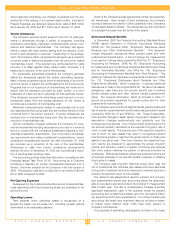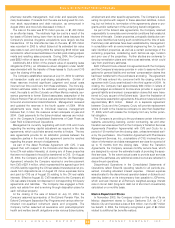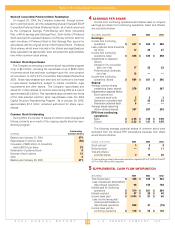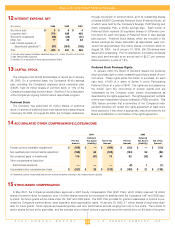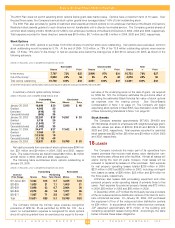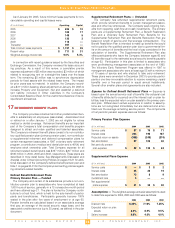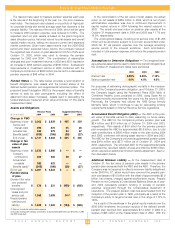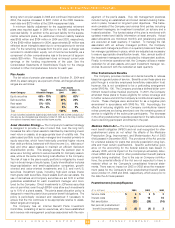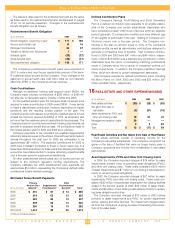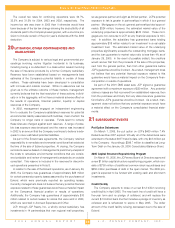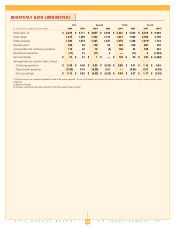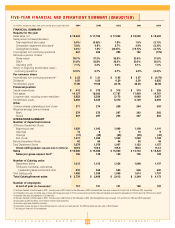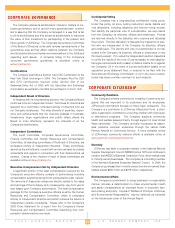JCPenney 2004 Annual Report Download - page 42
Download and view the complete annual report
Please find page 42 of the 2004 JCPenney annual report below. You can navigate through the pages in the report by either clicking on the pages listed below, or by using the keyword search tool below to find specific information within the annual report.
J.C. PENNEY COMPANY, INC.2 004 ANNUAL REPORT
Notes to the Consolidated Financial Statements
40
The 2001 Plan does not permit awarding stock options below grant-date market value. Options have a maximum term of 10 years. Over
the past three years, the Company’s annual stock option grants have averaged about 1.6% of total outstanding stock.
The 2001 Plan also provides for grants of restricted stock awards and stock options to non-employee members of the Board of Directors.
Restricted stock awards granted to such directors are not transferable until a director terminates service. The Company granted shares of
common stock totaling 24,024, 36,682 and 21,266 to non-employee members of the Board of Directors in 2004, 2003 and 2002, respectively.
Total expense recorded for these directors’ awards was $0.8 million, $0.7 million and $0.5 million in 2004, 2003 and 2002, respectively.
Stock Options
At January 29, 2005, options to purchase 13.8 million shares of common stock were outstanding. If all options were exercised, common
stock outstanding would increase by 5.1%. At the end of 2004, 10.8 million, or 78% of the 13.8 million outstanding options, were exercis-
able. Of those, 72% were "in-the-money" or had an exercise price below the closing price of $41.69 on January 29, 2005, as shown in the
following schedule:
(shares in thousands, price is weighted-average exercise price)
Exercisable Unexercisable Total
Shares % Price Shares % Price Shares % Price
In-the-money
7,797 72% $25 2,956 97% $31 10,753 78% $27
Out-of-the-money(1)
2,983 28% 56 95 3% 42 3,078 22% 55
Total options outstanding
10,780 100% $33 3,051 100% $31 13,831 100% $33
(1) Out-of-the-money options are those with an exercise price equal to or above the closing price of $41.69 at the end of 2004.
A summary of stock option activity follows:
(shares in thousands, price is weighted-average exercise price)
Outstanding Exercisable
Shares Price Shares Price
January 26, 2002
18,690 $ 30 5,840 $ 48
Granted
4,993 20
Exercised
(610) 15
Canceled/forfeited
(806) 38
January 25, 2003
22,267 $ 28 14,551 $ 33
Granted
5,136 20
Exercised
(1,843) 17
Canceled/forfeited
(1,083) 39
January 31, 2004
24,477 $ 27 17,642 $ 30
Granted
3,365 31
Exercised
(12,835) 19
Canceled/forfeited
(1,176) 46
January 29, 2005
13,831 $ 33 10,780 $ 33
Net cash proceeds from exercise of stock options were $248 mil-
lion, $31 million and $9 million in 2004, 2003 and 2002, respec-
tively. The related income tax benefit totaled $82 million, $4 million
and $1 million in 2004, 2003 and 2002, respectively.
The following table summarizes stock options outstanding at
January 29, 2005:
(shares in thousands, price is weighted-average exercise price)
Outstanding Exercisable
Exercise Remaining
Price Range Shares Price Term (Years) Shares Price
$11-below $20
3,384 $18 6.7 3,249 $18
$20-$29
1,620 21 7.1 1,603 21
$30-$39
5,668 33 6.7 2,864 36
$40-$49
2,072 46 1.8 1,977 46
$50-$71
1,087 71 2.8 1,087 71
Total
13,831 $33 5.7 10,780 $33
The Company follows the intrinsic value expense recognition
provisions of APB No. 25 as permitted by SFAS No. 123. As a
result, no compensation expense is recognized for stock options
since all options granted have an exercise price equal to the mar-
ket value of the underlying stock on the date of grant. As required
by SFAS No. 123, the Company estimates the pro-forma effect of
recording the estimated Black-Scholes fair value of stock options
as expense over the vesting period. See Stock-Based
Compensation in Note 1 on page 31. The Company will begin
expensing stock options in fiscal 2005. See discussion under Effect
of New Accounting Standards in Note 1 on page 33.
Stock Awards
The Company awarded approximately 567,000, 364,000 and
227,000 shares of stock to employees with weighted-average grant-
date fair values per share of $33.59, $19.43 and $20.09 in 2004,
2003 and 2002, respectively. Total expense recorded for restricted
stock awards was $22 million, $8 million and $5 million in 2004, 2003
and 2002, respectively.
16 LEASES
The Company conducts the major part of its operations from
leased premises that include retail stores, store distribution cen-
ters, warehouses, offices and other facilities. Almost all leases will
expire during the next 20 years; however, most leases will be
renewed or replaced by leases on other premises. Rent expense
for real property operating leases totaled $238 million in 2004,
$231 million in 2003 and $252 million in 2002, including contingent
rent, based on sales, of $26 million, $23 million and $24 million for
the three years, respectively.
JCPenney also leases data processing equipment and other
personal property under operating leases of primarily three to five
years. Rent expense for personal property leases was $72 million
in 2004, $80 million in 2003 and $85 million in 2002.
In December 2003, JCP notified the third-party service providers
of the six outsourced store distribution centers of its intent to termi-
nate contracted services. On January 30, 2004, JCP purchased
the equipment of four of the outsourced store distribution centers
for $34 million. In accordance with the related service contracts,
JCP assumed approximately $115 million of the building and
remaining equipment leases during 2004. Accordingly, the table
below includes these lease obligations.


